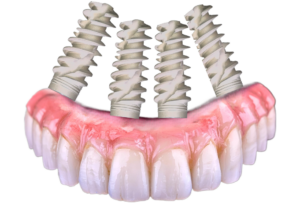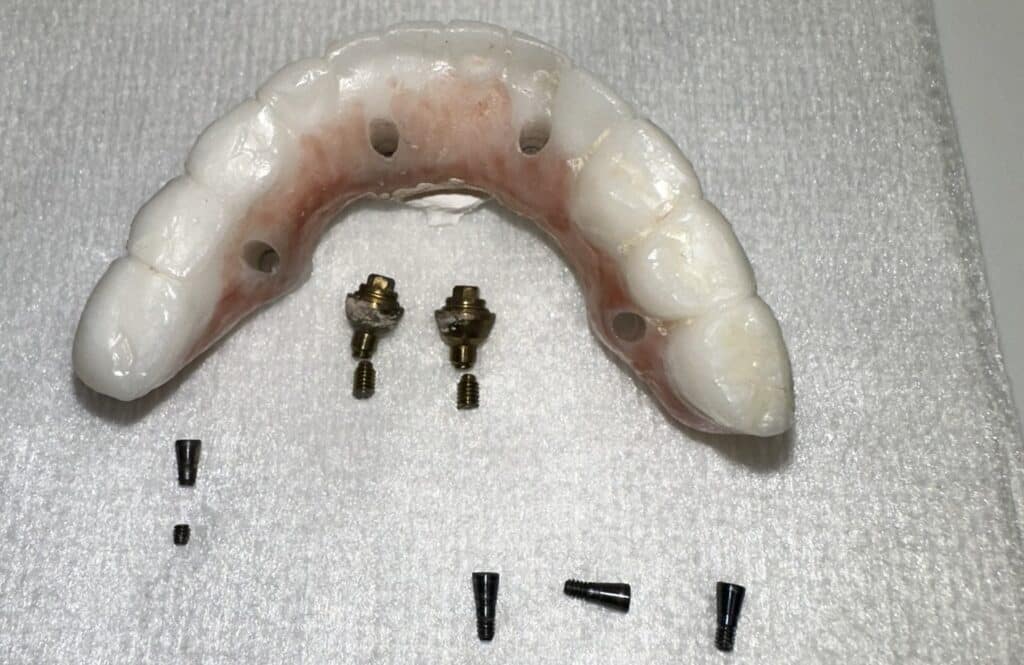 All-on-4 dental implants have gained widespread popularity as a better solution for people who wear dentures or face the scary prospect of losing their teeth and needing a new smile. Unlike traditional single-tooth implants, the all-on-4 procedure offers a faster, often more affordable alternative to conventional dental implants. In this blog post, we’ll explore the possible disadvantages a patient may experience with All-on-4 dental implants and provide some advice on how to avoid these outcomes.
All-on-4 dental implants have gained widespread popularity as a better solution for people who wear dentures or face the scary prospect of losing their teeth and needing a new smile. Unlike traditional single-tooth implants, the all-on-4 procedure offers a faster, often more affordable alternative to conventional dental implants. In this blog post, we’ll explore the possible disadvantages a patient may experience with All-on-4 dental implants and provide some advice on how to avoid these outcomes.
1. Expensive
 While All-on-4 implants can be more cost-effective than a complete set of individual implants, they still represent a significant investment. In Utah, the price per jaw can range from $20,000 to $35,000, depending on your specific needs. For many patients, this cost is a significant barrier to overcome. Patients often expect dental insurance to cover the complete cost, but unfortunately, most dental insurance pays only a fraction of the total cost.
While All-on-4 implants can be more cost-effective than a complete set of individual implants, they still represent a significant investment. In Utah, the price per jaw can range from $20,000 to $35,000, depending on your specific needs. For many patients, this cost is a significant barrier to overcome. Patients often expect dental insurance to cover the complete cost, but unfortunately, most dental insurance pays only a fraction of the total cost.
2. Not the Solution for All Patients
All-on-4 implants are an option for the right patient. Patients with severe bone loss in the jaw may need additional procedures, such as bone grafting, to build up the bone density required to support the implants. This not only adds to the cost but can also extend the timeline and complexity of treatment. Additionally, people with certain health conditions, like uncontrolled diabetes or weakened immune systems, may face heightened risks of complications. Lastly, some patients who have been in a denture for some time require more facial support than an all-on-4 can provide.
3. Longevity Not 100% Certain
All-on-4 dental implants are designed to be solid and durable but are not immune to wear and tear. Patients often want me to tell them that I can guarantee they will last forever, and unfortunately, this isn’t a promise any doctor can make. Over time, the prosthetic bridge attached to the implants may need repairs or replacements due to material degradation or bite force. The implants reside inside the bone, and if not cleaned well, they can cause bone loss and lead to implant failure.
4. Risk of Implant Failure
Although the success rate of All-on-4 implants is high, no surgical procedure is without risk. Implant failure, though relatively uncommon, can occur due to infection, poor oral hygiene, or complications with bone integration (osseointegration). For those who experience failure, the process of removing and replacing an implant can be complex and uncomfortable, potentially requiring further surgical intervention and healing time.
5. Adjustments in Oral Hygiene and Lifestyle
While All-on-4 implants can feel and function like natural teeth, maintaining them requires a rigorous oral hygiene routine. Failure to properly clean around the implants can lead to gum disease or peri-implantitis, which, if left untreated, can result in implant failure. Additionally, individuals who grind their teeth (bruxism) may need to take special precautions, such as using a night guard, to protect their implants.
6. Possible Changes in Sensation and Comfort
Some patients report feeling a difference in sensation when biting and chewing with All-on-4 implants compared to their natural teeth. While the implants aim to mimic natural teeth as closely as possible, they do not have the same nerve connections, potentially leading to a slight change in how food textures and temperatures are perceived.
7. Irreversible Procedure
One primary consideration is that All-on-4 implants require the removal of any remaining teeth in the arch, making the procedure irreversible. This is a permanent decision, and if, for any reason, the implants need to be removed or fail, replacing them may involve more invasive treatments. Patients should be fully informed and certain before committing to an All-on-4 procedure.
While All-on-4 dental implants offer a transformative solution for many seeking a reliable, long-lasting way to restore their smile, understanding the potential downsides is crucial. Financial considerations, the possibility of future maintenance, health suitability, and the irreversible nature of the procedure all play significant roles in making an informed decision. Consult with a qualified dental professional to discuss your circumstances, weigh the pros and cons, and explore all available options before moving forward.
 Dr. Hendriks TOP 10 Suggestions
Dr. Hendriks TOP 10 Suggestions
- Do your homework prior to booking a consultation by researching the procedure. This will allow more time to be spent on your specific needs rather than explaining the procedure.
- Bring a notebook with questions for the doctor and team.
- Bring a loved one with you to your consultations.
- Ask for recent pictures of patients who have completed the procedure.
- Don’t rush the decision. Before selecting an office, ask for time to read over all the consents and office policies.
- Stay on a strictly soft diet while healing.
- Invest in a new tooth brush and Waterpik.
- Take advantage of every maintenance visit and specifically ask for how you can improve your oral hygiene
- Communicate clearly by bringing your notebook with prepared questions at maintenance visits.
- Be proactive, and don’t wait till something hurts to go to the dentist.
Dr. Bryan H. Hendriks




